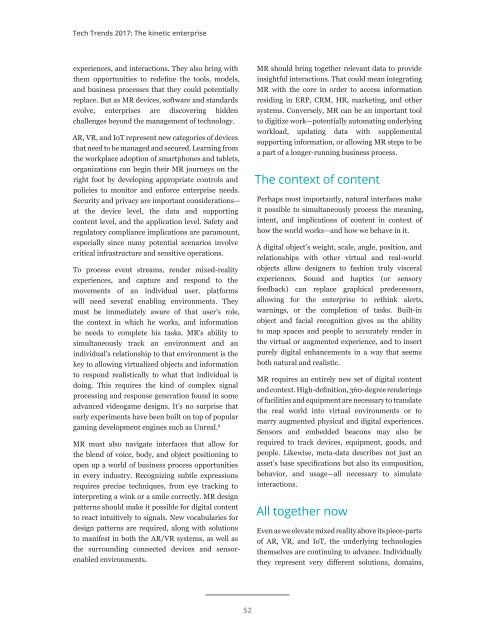Trending the trends Eight years of research
2kcf8xh
2kcf8xh
Create successful ePaper yourself
Turn your PDF publications into a flip-book with our unique Google optimized e-Paper software.
Tech Trends 2017: The kinetic enterprise<br />
experiences, and interactions. They also bring with<br />
<strong>the</strong>m opportunities to redefine <strong>the</strong> tools, models,<br />
and business processes that <strong>the</strong>y could potentially<br />
replace. But as MR devices, s<strong>of</strong>tware and standards<br />
evolve, enterprises are discovering hidden<br />
challenges beyond <strong>the</strong> management <strong>of</strong> technology.<br />
AR, VR, and IoT represent new categories <strong>of</strong> devices<br />
that need to be managed and secured. Learning from<br />
<strong>the</strong> workplace adoption <strong>of</strong> smartphones and tablets,<br />
organizations can begin <strong>the</strong>ir MR journeys on <strong>the</strong><br />
right foot by developing appropriate controls and<br />
policies to monitor and enforce enterprise needs.<br />
Security and privacy are important considerations—<br />
at <strong>the</strong> device level, <strong>the</strong> data and supporting<br />
content level, and <strong>the</strong> application level. Safety and<br />
regulatory compliance implications are paramount,<br />
especially since many potential scenarios involve<br />
critical infrastructure and sensitive operations.<br />
To process event streams, render mixed-reality<br />
experiences, and capture and respond to <strong>the</strong><br />
movements <strong>of</strong> an individual user, platforms<br />
will need several enabling environments. They<br />
must be immediately aware <strong>of</strong> that user’s role,<br />
<strong>the</strong> context in which he works, and information<br />
he needs to complete his tasks. MR’s ability to<br />
simultaneously track an environment and an<br />
individual’s relationship to that environment is <strong>the</strong><br />
key to allowing virtualized objects and information<br />
to respond realistically to what that individual is<br />
doing. This requires <strong>the</strong> kind <strong>of</strong> complex signal<br />
processing and response generation found in some<br />
advanced videogame designs. It’s no surprise that<br />
early experiments have been built on top <strong>of</strong> popular<br />
gaming development engines such as Unreal. 8<br />
MR must also navigate interfaces that allow for<br />
<strong>the</strong> blend <strong>of</strong> voice, body, and object positioning to<br />
open up a world <strong>of</strong> business process opportunities<br />
in every industry. Recognizing subtle expressions<br />
requires precise techniques, from eye tracking to<br />
interpreting a wink or a smile correctly. MR design<br />
patterns should make it possible for digital content<br />
to react intuitively to signals. New vocabularies for<br />
design patterns are required, along with solutions<br />
to manifest in both <strong>the</strong> AR/VR systems, as well as<br />
<strong>the</strong> surrounding connected devices and sensorenabled<br />
environments.<br />
MR should bring toge<strong>the</strong>r relevant data to provide<br />
insightful interactions. That could mean integrating<br />
MR with <strong>the</strong> core in order to access information<br />
residing in ERP, CRM, HR, marketing, and o<strong>the</strong>r<br />
systems. Conversely, MR can be an important tool<br />
to digitize work—potentially automating underlying<br />
workload, updating data with supplemental<br />
supporting information, or allowing MR steps to be<br />
a part <strong>of</strong> a longer-running business process.<br />
The context <strong>of</strong> content<br />
Perhaps most importantly, natural interfaces make<br />
it possible to simultaneously process <strong>the</strong> meaning,<br />
intent, and implications <strong>of</strong> content in context <strong>of</strong><br />
how <strong>the</strong> world works—and how we behave in it.<br />
A digital object’s weight, scale, angle, position, and<br />
relationships with o<strong>the</strong>r virtual and real-world<br />
objects allow designers to fashion truly visceral<br />
experiences. Sound and haptics (or sensory<br />
feedback) can replace graphical predecessors,<br />
allowing for <strong>the</strong> enterprise to rethink alerts,<br />
warnings, or <strong>the</strong> completion <strong>of</strong> tasks. Built-in<br />
object and facial recognition gives us <strong>the</strong> ability<br />
to map spaces and people to accurately render in<br />
<strong>the</strong> virtual or augmented experience, and to insert<br />
purely digital enhancements in a way that seems<br />
both natural and realistic.<br />
MR requires an entirely new set <strong>of</strong> digital content<br />
and context. High-definition, 360-degree renderings<br />
<strong>of</strong> facilities and equipment are necessary to translate<br />
<strong>the</strong> real world into virtual environments or to<br />
marry augmented physical and digital experiences.<br />
Sensors and embedded beacons may also be<br />
required to track devices, equipment, goods, and<br />
people. Likewise, meta-data describes not just an<br />
asset’s base specifications but also its composition,<br />
behavior, and usage—all necessary to simulate<br />
interactions.<br />
All toge<strong>the</strong>r now<br />
Even as we elevate mixed reality above its piece-parts<br />
<strong>of</strong> AR, VR, and IoT, <strong>the</strong> underlying technologies<br />
<strong>the</strong>mselves are continuing to advance. Individually<br />
<strong>the</strong>y represent very different solutions, domains,<br />
52


